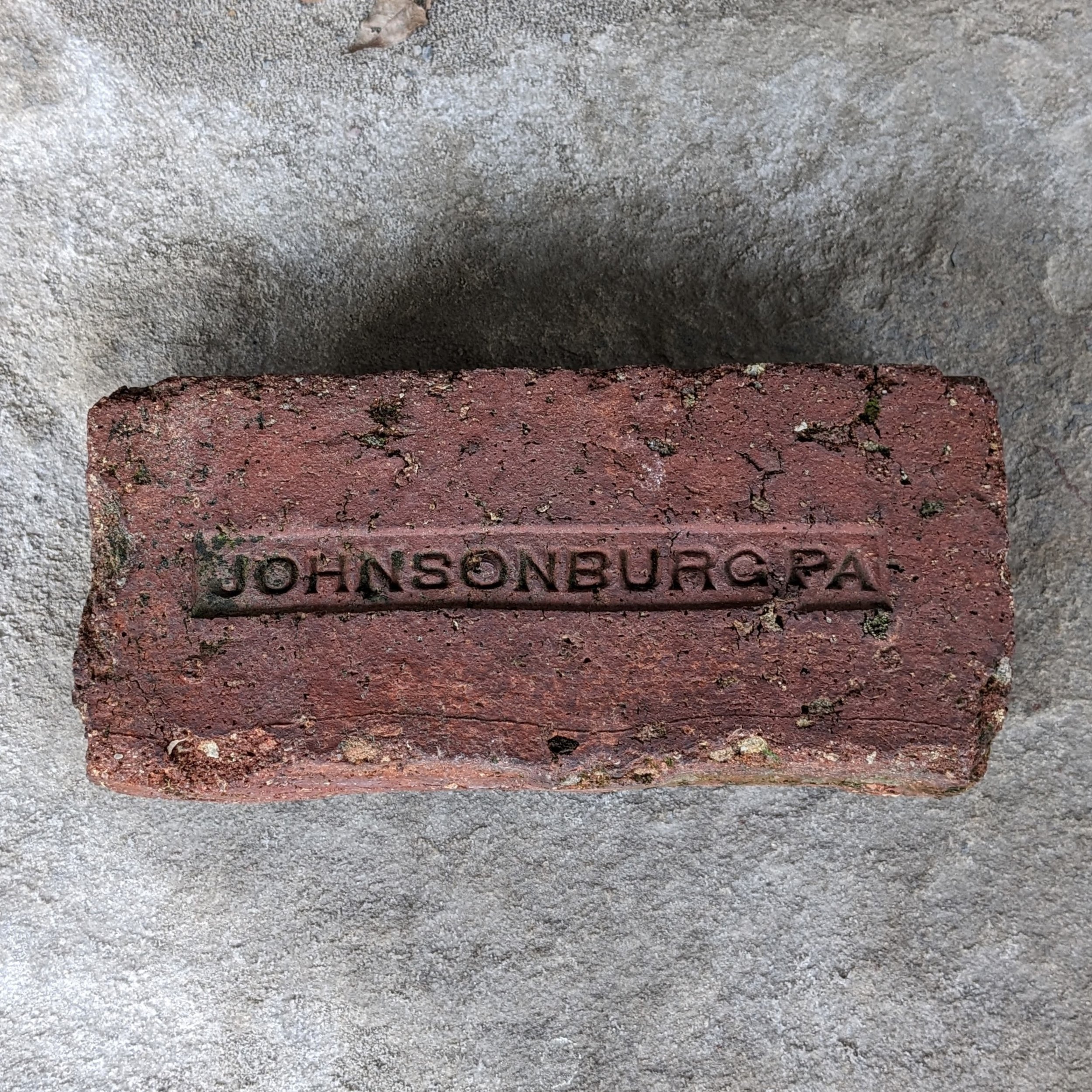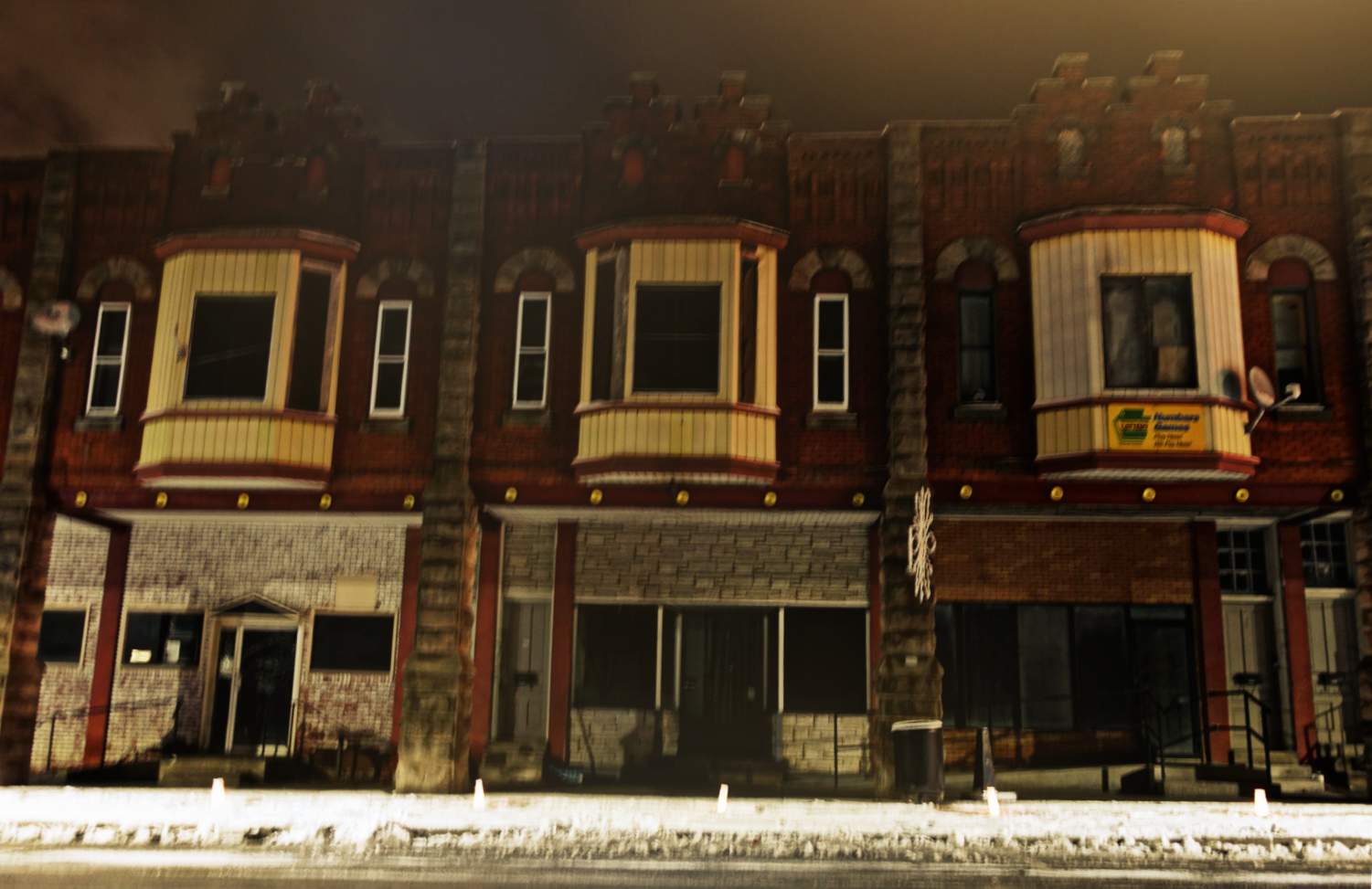Charles E. Hathaway, after apprenticing under David Purington of Somerset, Massachusetts, decided at age 18 to go into the pottery business for himself. In that year of 1871 there existed a large market in New England for earthen ware, stoneware, flower pots, tile, and electrical insulators made from clay and Charles enjoyed a reputation as a first-class potter. Charles, and eventually his son, Howard, became very astute at the kiln firing process of their products and the type of clay required to make the best pottery. While their creations lacked flair they were generally practical and, useful, and long-lasting.
In 1888 Meylert and Lewis Armstrong, paper-making brothers of Lock Haven and Philadelphia, Pennsylvania, incorporated the Clarion Pulp and Paper Company with the intention of erecting a paper mill in Johnsonburg, Pennsylvania. In Johnsonburg they had the perfect situation, railroad access to ship their paper, plenty of water needed for the paper-making process, gushing gas wells, and access to thousands of acres of timber for the necessary raw material. They also noticed that under the topsoil of the region lay vast deposits of clay that as the community’s roads were being built was being used to make sun-baked bricks for house building purposes. (At the location of the current Community Center property).
At Lock Haven the brothers had experienced the devastation of fire on their wooden paper factory that had almost ruined their business and it followed that if they could obtain enough bricks the brothers could build a Johnsonburg paper mill nearly impervious to flame. But the little sun dried brick works on Market Street could not possibly produce enough blocks to sustain an ambitious construction schedule. So the Armstrong’s turned to friends in Boston, Massachusetts and the Somerset Pottery Company, under the leadership of Charles E. Hathaway, and the financing of Arnold Borden Sanford, wealthy cotton merchant, became the Somerset and Johnsonburg Manufacturing Company, specializing in bricks.
Quickly, with the oversight of Hathaway, kilns were erected in the Glen Mayo section of Johnsonburg, gas wells were dug to fire the bricks, and clay extracted from the surrounding hills and valley. Building bricks were formed and fired and within a year the Clarion Mill and the Highland Mill stood almost fireproof and brick-strong along the banks of the Clarion River. In 1897 the new Sulphite Mill would be added. At its peak the Somerset and Johnsonburg factories could produce 20,000,000 building bricks a year. In addition, the plants turned out paving brick, enameled brick, fireproof brick, furnace linings, and terra cotta water pipes and tiles. The brick works seemed to be a rousing success story.
But soon nearby competitors began to appear; the Ridgway Press Brick Company (1897), the Shawmut Brick Company (1897), and the Jamestown Shale Paving Company (1890), and the local brick market tightened. Also, several calamities befell the Company, 100 tons of clay belonging to Somerset and Johnsonburg sank in the Providence, Rhode Island harbor in October 1894, Charles E. Hathaway resigned in 1893 as president taking his expertise with him, and many other brick companies entered the field in New England. With the great brickbuilding projects in Johnsonburg completed and sales plummeting, the company went defunct in 1898. Arnold B. Sanford, who had financed the venture, filed for bankruptcy. He listed over $300,000 in liabilities, including $61,000 of notes he had endorsed to keep the Somerset and Johnsonburg Manufacturing Company afloat. His largest creditors were banks in Boston, New Bedford, and Falls River, MA. As collateral, he had provided bonds of the Somerset and Johnsonburg Manufacturing Company, now of questionable value. His assets were listed as furniture of $250.
The aforementioned New England banks were not keen on owning a brick factory in the boondocks of Northwestern Pennsylvania; they were used to financing the numerous textile mills in their area, so they enticed financier E. H. Milliken, President of the Boston Engraving Company, to reorganize the Somerset and Johnsonburg Manufacturing Company. In March 1898 the company was organized as the Johnsonburg Vitrified Brick Company in Portland, Maine; E. H. Milliken, President. They hired Alfred Yates as its general manager.
Yates, born in Great Malvern, England in 1855, came to America as a teenager and eventually engaged in the manufacture of common brick in Cambridge, Massachusetts. He moved to Johnsonburg to operate the factory and the Johnsonburg Vitrified Brick Company began to flourish.
The Johnsonburg Vitrified Brick Company made headway in the brick industry for several reasons; the neighboring clay was perfect containing the right amounts of silica (sand), alumina (clay), lime, iron oxide, and magnesia, cities and towns were anxious to get out of the mud filled streets, and Alfred Yates kilns, patented in 1899, made the production of road pavers more efficient. The Johnsonburg Vitrified Brick Company road pavers were wanted everywhere. Pavers marked “Johnsonburg Pavers” laid over six inches of concrete on top of sand covered the streets of Baltimore, Maryland and Brooklyn, New York while other red-colored “Johnsonburg Pavers,” placed on shale and sand lined the byways of rural communities. Although asphalt paving began in 1889 the asphalt process remained expensive in its infancy and paving brick was stronger and more durable. Ice, snow, and rain had little effect on the non-porous pavers. Water ran off them like a seal’s skin. Wagon wheels lined with iron and shod horses made little dent in the indestructible blocks.
However, Alfred did not stay long with the new Johnsonburg Company, moving on to the Shawmut, Pennsylvania Brick Company in 1904 taking with him his new patent, the Downdraft Continuous Brick Kiln, and the cream colored “Shawmut” brick became famous across the eastern United States as the strongest and lightest brick made to that time.
In the same year the Johnsonburg Vitrified Brick Company changed hands becoming the property of Edward D. Emerson. Emerson had made his fortune in hardware sales and soda water manufacturing in Boston, Massachusetts. It is not known if the new ownership caused Alfred Yates to change companies. The Yates family resided in Clarion Heights near the factory while he worked in Johnsonburg. The Johnsonburg Vitrified Brick Company was locally known as the “Heights Brick Works” during its existence.
Henry Hasbrouck came from the Kirkville Brick Company of Auburn, New York to Johnsonburg to replace Alfred Yates as general manager of the Johnsonburg Vitrified Brick Company and his motto was “Make brick, make them well, and burn them thoroughly.” In 1909, owing to a large amount of spring business and low stock the Johnsonburg Vitrified Brick Company began seasonal operations on March 15th, operating at full capacity. Hasbrouck left the Company that spring to be replaced by L. I. Foster. The following year Kendrick J. Lucius took over as plant superintendent. Unfortunately, the advent of automobiles requiring smoother roadways, the ever decreasing costs of asphalt, and the invention of the Tarmac road paving process “tar and chip” by Edgar Purnell Hooley in 1901, took its toll on the paver business and in 1910 the Johnsonburg Vitrified Brick Company fell dormant.
Johnsonburg brick laborers were not out of work long when in 1910 Sherwood C. Martin and Roswell G. Yingling, with $100,000 in capital, opened the Yingling-Martin Brick Works, originally the Pfotenhhauer-Nesbit Company of New York, at the east end of Johnsonburg. Although the company did make pavers, their specialized product was a building brick of different decorative colorful hues marked with a “YS” and marketed as Promenade and Artbrique. The old red-faced monotonous brick buildings were now a faint memory. Brick faces now shone in various rough-textured tints of mixed red, green, blue and purple. The Yingling-Martin building brick works was off and running.
Roswell Gardner Yingling, born in West Freedom, Pennsylvania around 1853, had the most curious route to brickmaker as anyone who ever molded a block. He graduated from West Freedom Academy as a teacher and taught in McKean and Clarion County Schools. Furthering his education at Edinboro State Normal School (now Edinboro University) in Edinboro, Pennsylvania and the National University of Lebanon, Ohio he soon landed a professor position at the Carrier Seminary Methodist School in Clarion, Pennsylvania. In 1886, through his efforts, the Carrier School was sold and became the Clarion State Normal School (now Clarion University). Since its inception he was stockholder, teacher, business manager, and trustee at the school at least until 1913. He moved to Wilkensburg, Pennsylvania in 1902.
His partner in the Yingling-Martin Brick Works, Sherwood Christy Martin, born in 1857 in Perry, Clarion County began his career working in a grist mill in Richland, Pennsylvania in Lebanon County. By 1884 Sherwood had moved to Pittsburgh, Pennsylvania where he took a position as a bookkeeper. In 1892 he organized the manufacture of “Kittanning Brick” and by 1893 Martin co-owned the Buente-Martin stone cutting and building works of Pittsburgh with Rose Buente. In 1895 he organized the Martin Brick Works for the purpose of the distribution of bricks. This type of company was not uncommon in those days as many brickmaking companies used middlemen to sell and distribute their bricks. The G. R. Twichell & Company, G. R. Twichell, President, of Boston sold bricks for the Johnsonburg Vitrified Brick Company, the Shawmut Brick Company, and the Ridgway Press Brick Company throughout the New England states. Martin and Alfred Yates were well-respected in their field, both on occasion addressing the National Brick Manufacturing Association on brick-making, production, firing efficiency, and product tariffs and taxes.
Roswell G. Yingling and Sherwood C. Martin traded off the Presidency of the Yingling-Martin Brick Works until Yingling’s death in 1922. He was honored by an obituary tribute in the Brick and Clay Record, a prominent brick manufacturer magazine of the era.
Sometime in the 1920’s the Yingling-Martin Brick Works ceased production but reopened in 1928 with new machinery and a conveyor line that would bring new found superior clay from Dill Hill to the plant. However, the stock market crash of 1929 and the subsequent Great Depression soon left the kilns cold and closed forever.
Sherwood C. Martin died in 1932 and his obituary notes only that he was the current President of the Kittanning Brick Company.
The Johnsonburg Vitrified Brick Company suffered a similar fate. In 1914 after four years of inactivity, the A. N. Broadhead Company, Almet Norval Broadhead, President, of Jamestown, New York purchased the factory from Emerson and Gray of Boston, and resumed operations on and off until at least 1930. In 1916 it was rumored the plant was to become a munitions factory but nothing ever came of that plan. Almet Broadhead’s father made a fortune in Jamestown, organizing the Jamestown Worsted Textile Mill, and Almet followed suit by making his own fortune with his brick paving entity, the Jamestown Shale Paving Company. Ironically, considering most of Jamestown had once been paved with its bricks, the Company refused in later years to pay its assessment for asphalting the streets bordering the Company’s premises. The Johnsonburg Vitrified Brick Company went out of business permanently during the Great Depression.
“Johnsonburg, PA” bricks, “Johnsonburg Pavers” and “YS” bricks are collectors’ items now and old postcards depicting the Johnsonburg Vitrified Brick Works and the Yingling-Martin Brick Works can be located on the Internet but the Companies efforts at sustaining viability were apparently just “a few bricks shy of a whole load.”
NOTES:
Charles Hathaway, after he left the Somerset and Johnsonburg Manufacturing employ, let his son, Howard, operate the Hathaway Pottery. Charles turned to cultivating and selling fruit in Somerset, MA, a successful venture he ran until his death in 1944.
Arnold Borden Sanford, the former wealthy cotton merchant and one-time owner of the famous Sanford Spinning Mill, did not die destitute. Although he resided alone in boarding houses while he worked as a textile mill manager he married late in life and worked in the textile industry until his death.
Alfred Yates, the brilliant kiln’s man, stuck with the Shawmut Brick Company acting as its president until his death on his estate, the Homestead Farm, near Bedford MA in 1918. Before coming to Johnsonburg he partnered with G. R. Twichell until June 1897 when he dissolved the partnership leaving G. R. with all liabilities and accounts payable by mutual consent. Alfred later used Twichell to advertise and sell his Shawmut bricks. Interestingly, he assigned both his patents to his wife, Jessie, and in 1910 she sued the Johnsonburg Vitrified Brick Works for non-payment of a debt owed to her of $500 per kiln agreed upon when Alfred left their employ. On appeal she won the case. Alfred’s son, Ernest Stuart Yates, who worked for his father for many years, married Arabella Ward and they had a son, Sydney Ward Yates. Arabella and son did not leave the Johnsonburg area when father-in-law Alfred and husband Ernest did in 1904. Arabella and young Sydney, born in 1904, instead resided with her parents John and Annie Ward, owners of the Ward dairy farm, on the old Wilcox Road in Wardvale. (Possibly the Shaffer Farm). The Wardvale Cemetery in Johnsonburg is probably the namesake of John and Annie Ward. Arabella and Ernest Yates likely divorced as he remarried. The son of Sydney Ward Yates, Sydney Yates, was once Johnsonburg Borough Manager, 1970-71.
Philip Crotzer, age 20, and Ed Hegland, age 15, lived with the Ward family and were dairy farm laborers in 1910.
The Shawmut Brick Company was later owned by the Shawmut Mining Company. The name Shawmut Brick Company is still registered as active in New York State with jurisdiction in Pennsylvania. It is listed as a foreign business corporation with its address as 1110 Prudential Bdlg, Buffalo, NY.
E. H. Milliken spent his early years clerking at his father’s Pine Cottage boarding house in Old Orchard, Maine. His first name was Edson.
Roswell G. Yingling and Sherwood C. Martin, unlikely partners, were likely connected through relatives; Martin’s mother was Elisabeth Yingling.
Presently, on the site of the former Yingling-Martin Brick Works, is “The Old Brickyard”, a combination trucking company, Subway, and convenience store.
Bricks are on loan from another local historian and JAHS alumni, Allen Terry Fitch
Kevin (Reg) Barwin
2015
Kevin Barwin, a Johnsonburg native, who spent his youth peddling newspapers in Johnsonburg and reading the newsprint, while walking his routes, acquired a taste for the past.
THE PAPER BOY FROM THE PAPER CITY, More on his book: here

























